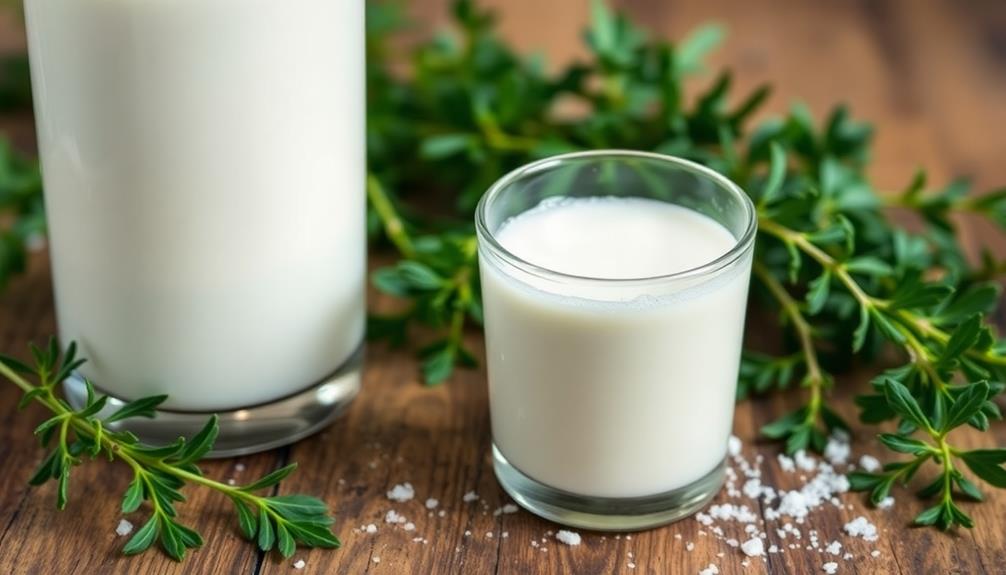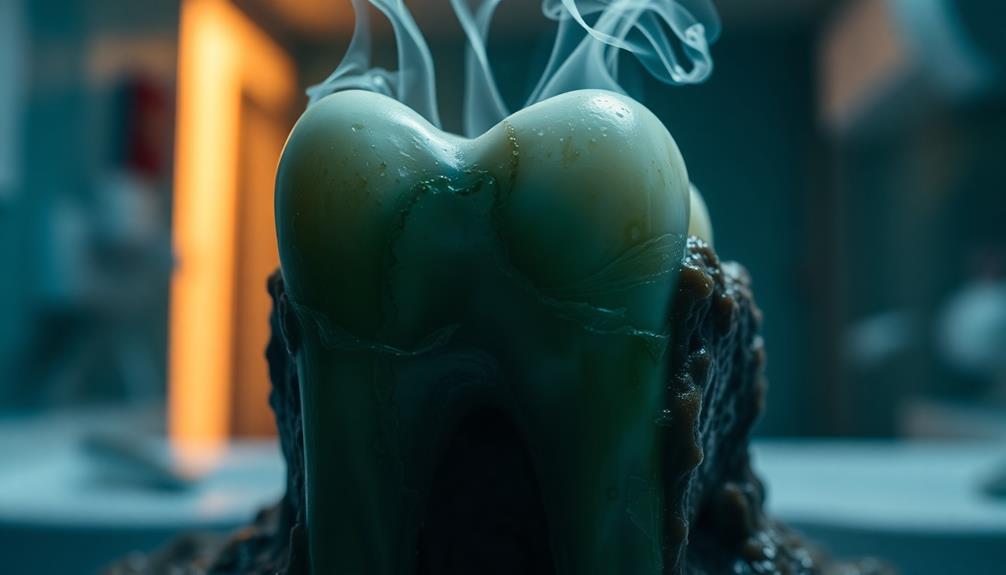Buttermilk has a unique, tangy smell that's quite distinct and often reminds you of strong yogurt. If it's fresh, you'll notice a pleasant sour aroma, but if it smells overwhelmingly sour or musty, it's time to throw it away. Fresh buttermilk adds excitement to your kitchen, especially when you're making yummy pancakes or biscuits! Cultured buttermilk tends to have a milder scent, which many people enjoy. Remember, a good smell indicates freshness, while a rancid odor signals spoilage. Want to know more about how to use buttermilk in your favorite recipes?
Key Takeaways
- Fresh buttermilk has a distinct tangy, sour aroma reminiscent of strong yogurt, indicating quality and freshness.
- Spoiled buttermilk emits an overwhelming sour and musty odor, signaling that it should be discarded.
- Cultured buttermilk has a milder tangy aroma due to specific live cultures used during fermentation.
- Properly stored buttermilk should smell like mild vinegar, serving as a freshness indicator in cooking.
- The delightful buttermilk scent evokes nostalgia and cultural connections, especially in Southern cuisine.
Introduction
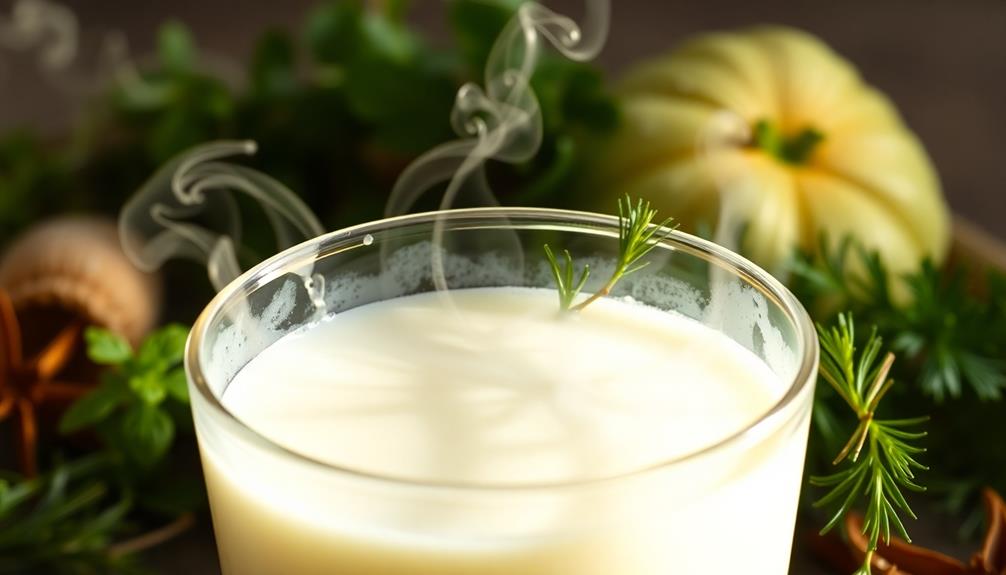
Buttermilk's unique aroma often sparks curiosity among those unfamiliar with it. You might notice its distinct sour smell, which actually comes from the fermentation process. Don't worry! This tangy aroma is perfectly normal for quality buttermilk. It's similar to the scent of strong yogurt rather than something spoiled or rancid.
When you encounter the buttermilk smell, remember that a pleasant, tangy aroma indicates freshness. However, if you catch an off-putting rancid odor or excessive sourness, that's a sign that the buttermilk has gone bad and should be tossed out. The fermentation process creates this sharp, slightly buttery scent, which can vary a bit based on how it was made.
If you're ever unsure, just take a good whiff! Fresh buttermilk will have that recognizable sour note that might remind you of a festive kitchen filled with baked goods.
It's an ingredient that can elevate your recipes, from pancakes to dressings. So, embrace the buttermilk smell, and let it guide you in discovering the wonders of this unique dairy product!
Description of the Smell
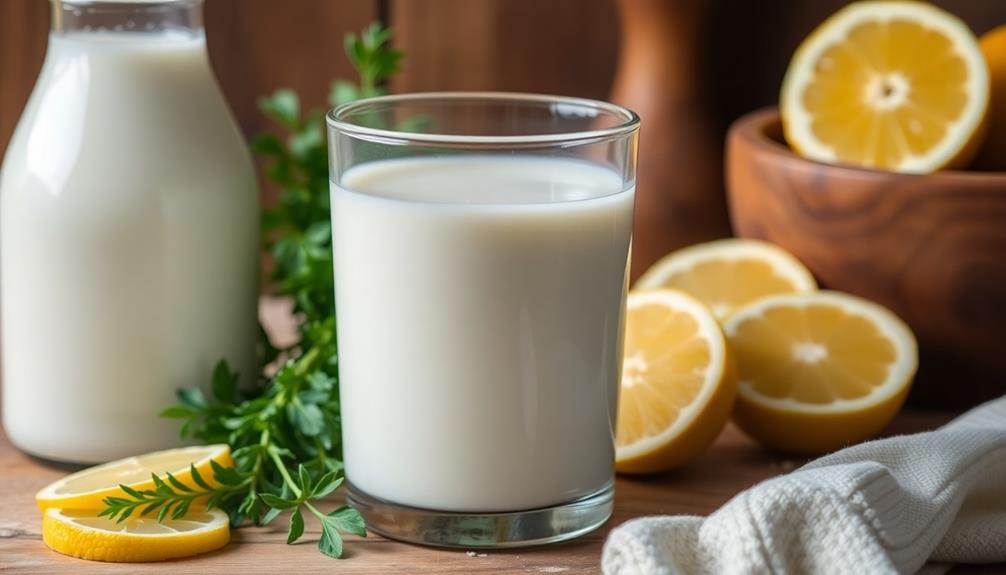
The smell of buttermilk is unmistakable, characterized by its tangy, sour notes that hint at its fermentation process. When you take a whiff, you'll notice a distinct sour smell, similar to strong yogurt, which can be quite pleasant if the buttermilk is fresh. This tangy smell tells you that fermentation has taken place, making it a key element of buttermilk's charm. The complexity of buttermilk’s aroma often evokes comparisons to other fermented dairy products, yet it possesses a unique balance of richness and acidity. Alongside this culinary scent profile, you might wonder, *what does shea butter smell like*? Unlike the sour, tangy nature of buttermilk, shea butter carries a subtle nutty and earthy fragrance, often described as mild and understated, making it a versatile companion for both skincare and aromatherapy.
Cultured buttermilk, often found in stores, usually has a milder aroma compared to traditional buttermilk. A pleasant aroma indicates good quality, so you can feel confident to use it in your recipes.
However, be cautious! If you catch an overwhelming sour or off-putting odor, it's a sign of spoilage. Rancid milk smells musty and should never be consumed.
To sum it up, when you encounter buttermilk, look for that delightful tangy scent. It's a great indication that you've got a quality product ready for cooking or baking.
Just be sure to trust your nose—if it smells off, it's best to discard it. Enjoy the delicious possibilities that fresh buttermilk can bring!
Source and Composition

The smell can change depending on the type of milk used and how it's fermented. For instance, cultured buttermilk tends to have a more pronounced tangy aroma. This is due to the specific live cultures used during fermentation, adding to the unique scent.
These live cultures not only affect the smell but also enhance the flavor profile, making buttermilk a favorite in cooking and baking.
If you ever encounter buttermilk with an overwhelming sour odor, it might be a sign of spoilage, so it's best to check before using it in your favorite dishes.
Enjoying buttermilk means embracing its delightful aroma and tangy taste, which can elevate any recipe it touches!
Typical Scenarios or Environments
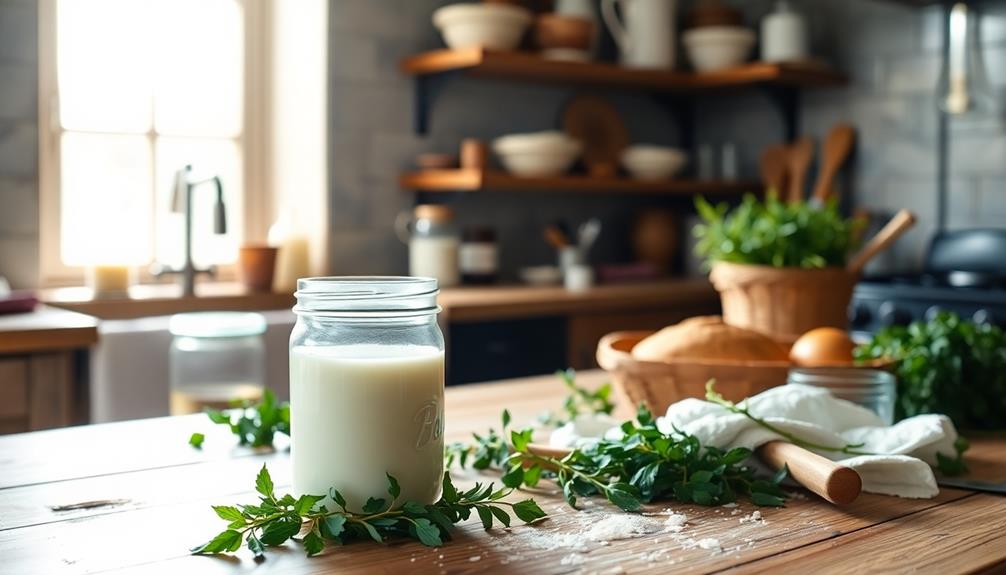
In many kitchens, the sharp, tangy smell of buttermilk can instantly elevate the atmosphere, signaling delicious dishes on the way. You might notice this fresh aroma while flipping pancakes or mixing up a batch of fluffy biscuits. The fermentation process gives buttermilk its unique scent, which often resembles strong yogurt instead of sour milk, hinting at its quality.
When you open the fridge, the smell of properly stored buttermilk should remind you of mild vinegar. If it starts to smell overwhelmingly sour, it's time to toss it out. Cultured buttermilk usually has a more pronounced tangy aroma compared to traditional varieties, adding that extra zing to your recipes.
In festive settings, like family gatherings or holiday meals, the scent of buttermilk wafting through the air can create excitement. You might sprinkle it into salad dressings or use it in marinades, enhancing flavors with that delightful tang.
Emotional or Cultural Associations
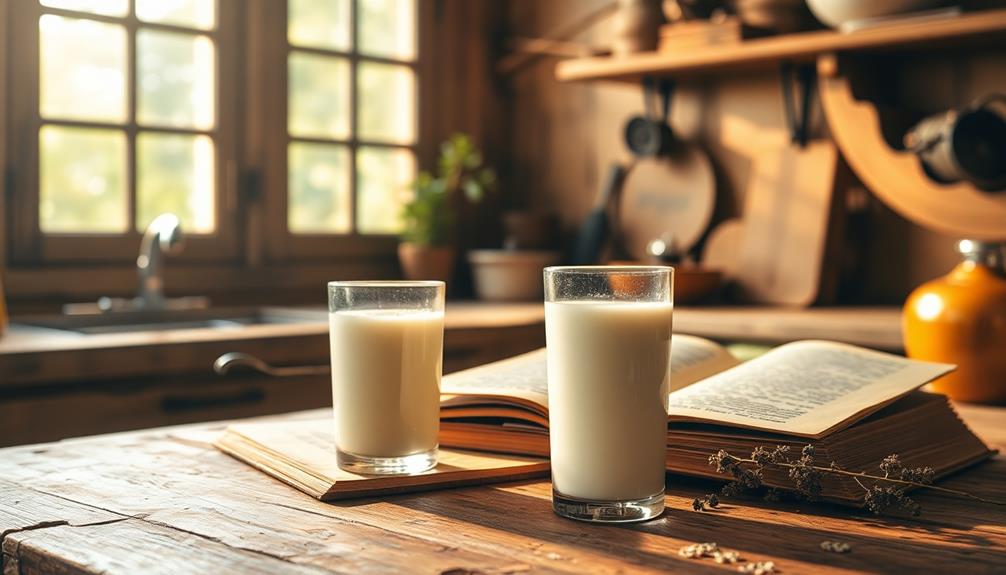
Few scents can evoke as much nostalgia and warmth as buttermilk. The tangy, slightly sour smell of buttermilk can transport you back to family gatherings and home-cooked meals. In Southern cuisine, this unique aroma is deeply tied to comfort foods like fluffy biscuits and crispy fried chicken. You might find yourself reminiscing about those special moments spent around the dinner table, sharing stories and laughter.
Buttermilk's smell often reflects cultural connections, reminding you of traditions passed down through generations. The fermentation process of buttermilk adds to its charm, as it represents the rustic qualities of farm life. This connection to agrarian roots makes the scent feel even more special.
When you catch a whiff of buttermilk, it might inspire your creativity in the kitchen. You may want to experiment with this ingredient in various dishes, knowing it holds a place in many cultures.
Whether it's used in pancakes or salad dressings, buttermilk brings comfort and nostalgia to your cooking. So, the next time you smell buttermilk, let it remind you of those cherished moments and the joy of preparing delicious meals for loved ones.
Health or Safety Considerations
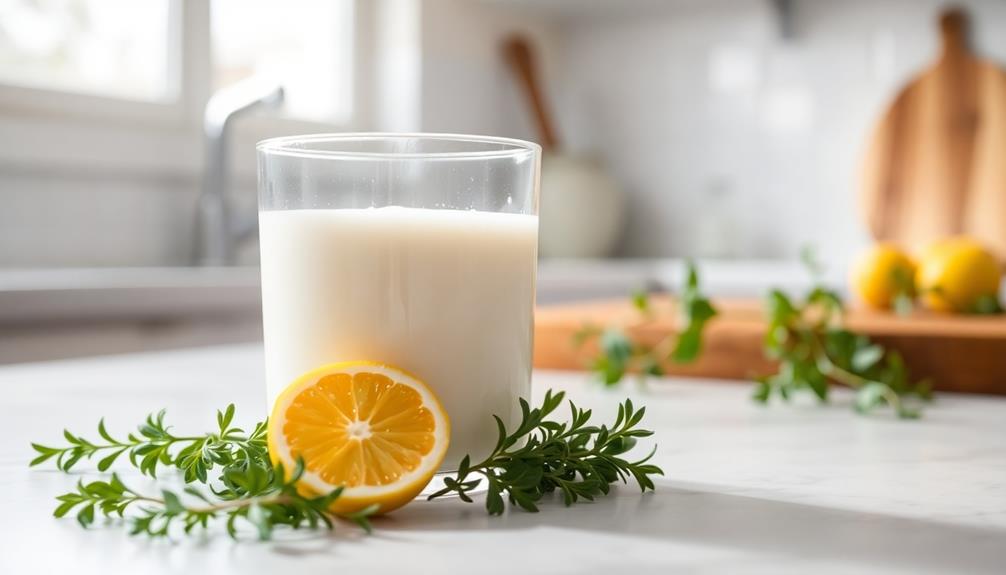
When you open a carton of buttermilk, it's essential to pay attention to its smell. Fresh buttermilk should have a mild, tangy aroma, but if you detect a strong odor or an overpowering sour scent, it's a sign of bad buttermilk. Spoiled buttermilk may contain harmful bacteria, which can lead to foodborne illnesses if consumed.
Always check the smell, even if the expiration date hasn't passed. Spoilage can happen sooner than expected, so it's best to trust your nose.
If buttermilk has been left out at room temperature for more than two hours, it's time to toss it out. This is because harmful bacteria can develop quickly, increasing health risks.
If you or someone in your household has a compromised immune system, be especially cautious. Spoiled dairy can pose serious health risks to those more vulnerable.
Final Thoughts
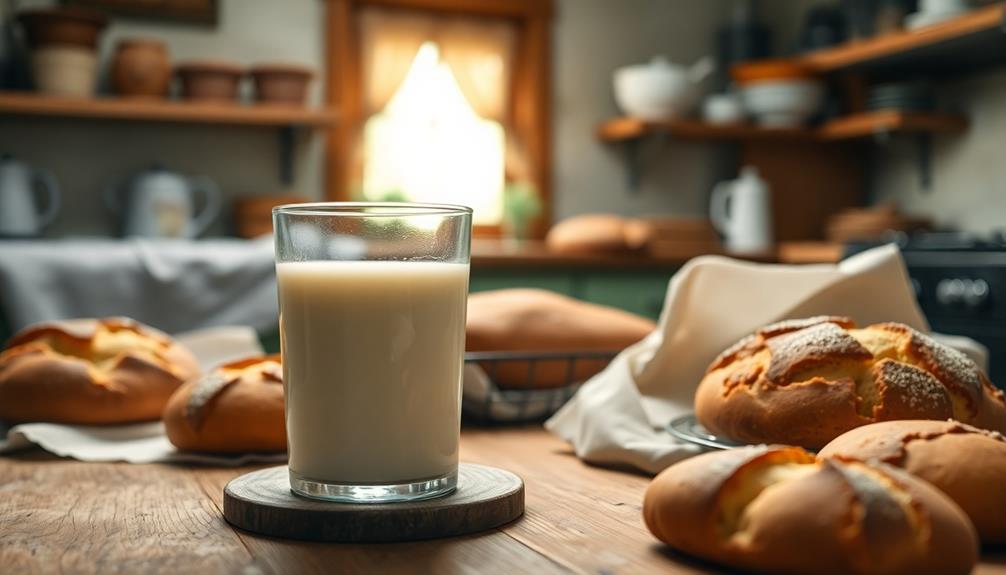
Buttermilk is a versatile ingredient that can elevate your cooking and baking, but it's crucial to ensure it's fresh before using it. The smell of buttermilk is a key indicator of its freshness. When you open a container, take a moment to inhale the aroma. A fresh buttermilk smell should be slightly sour, much like strong yogurt, but it shouldn't overwhelm you.
If you catch a whiff of a sharp, buttery scent, that's a sign of healthy fermentation. However, if the buttermilk smells rancid or has an unpleasant odor, it's time to say goodbye to it. Remember, a mild vinegar scent can be acceptable, but a strong, foul smell definitely signals spoilage.
Check the smell regularly. If it has a pleasant tangy aroma, you're good to go! But if you notice any off-putting scents, don't risk it; toss it out.
Fresh buttermilk can add a delightful touch to your recipes, making them taste amazing. By being mindful of the smell and practicing safety, you can enjoy the wonders of this wonderful ingredient without worry. Happy cooking!
Frequently Asked Questions
What Kind of Smell Does Buttermilk Have?
When you think about buttermilk's smell, you might notice a creamy, tangy aroma. It's fresh with a mild sourness, but if it smells rancid, it's definitely gone bad and you shouldn't use it.
How to Tell if Buttermilk Is Off?
To tell if buttermilk's off, check for an unpleasant sour odor, chunky texture, or mold on the surface. Always inspect visually for discoloration; these signs indicate it's time to toss it out.
How Would You Describe the Taste of Buttermilk?
You'd find buttermilk has a creamy, tangy flavor with a hint of buttery richness. Its mild acidity balances sweetness, making it perfect for enhancing pancakes, biscuits, and dressings, bringing a delightful twist to your dishes.
What Is the Flavor of Buttermilk?
You'll find buttermilk has a tangy, slightly sour flavor that adds depth to dishes. Its creamy texture complements both sweet and savory recipes, making it a versatile ingredient in your culinary adventures. You'll love its richness!
